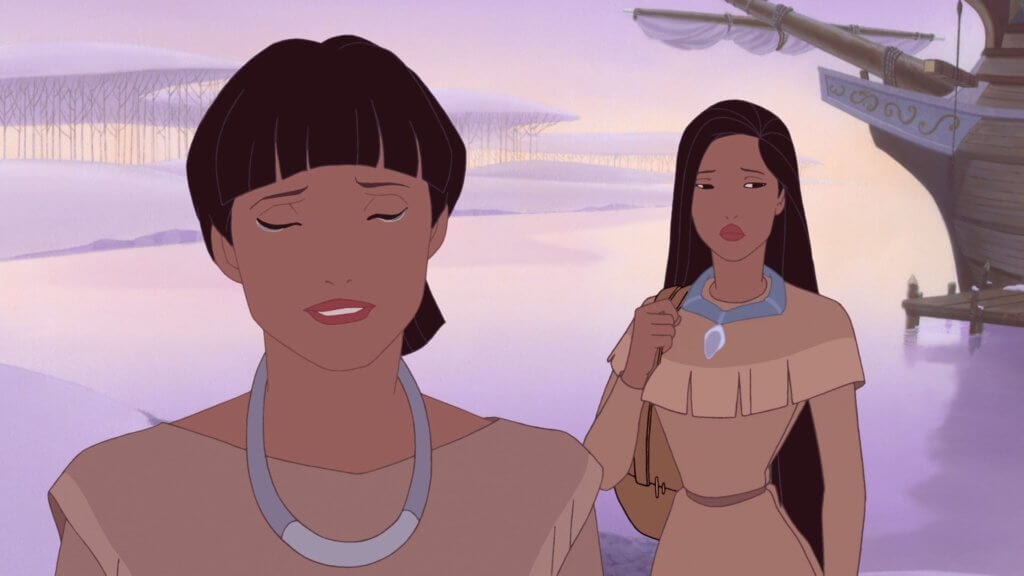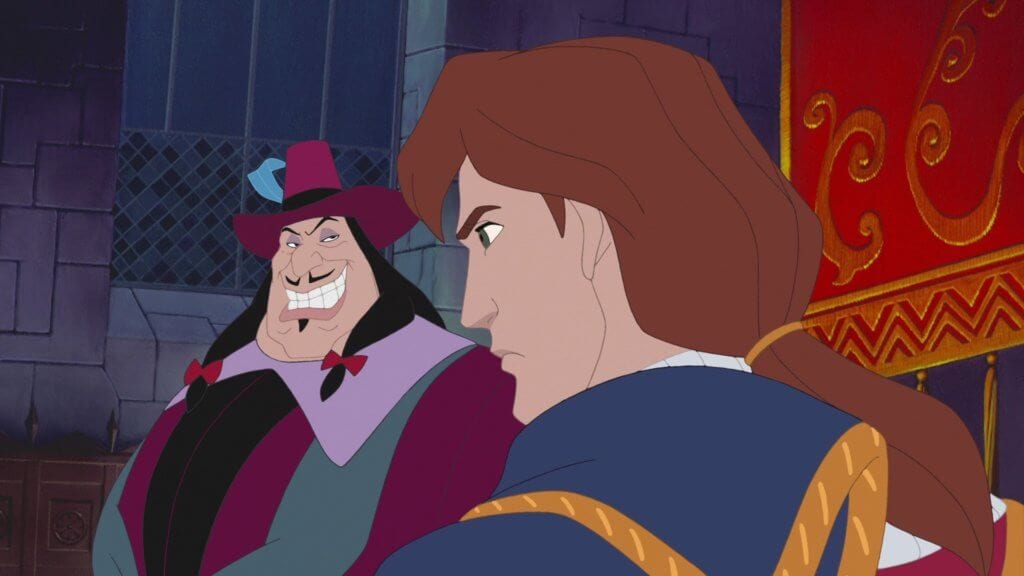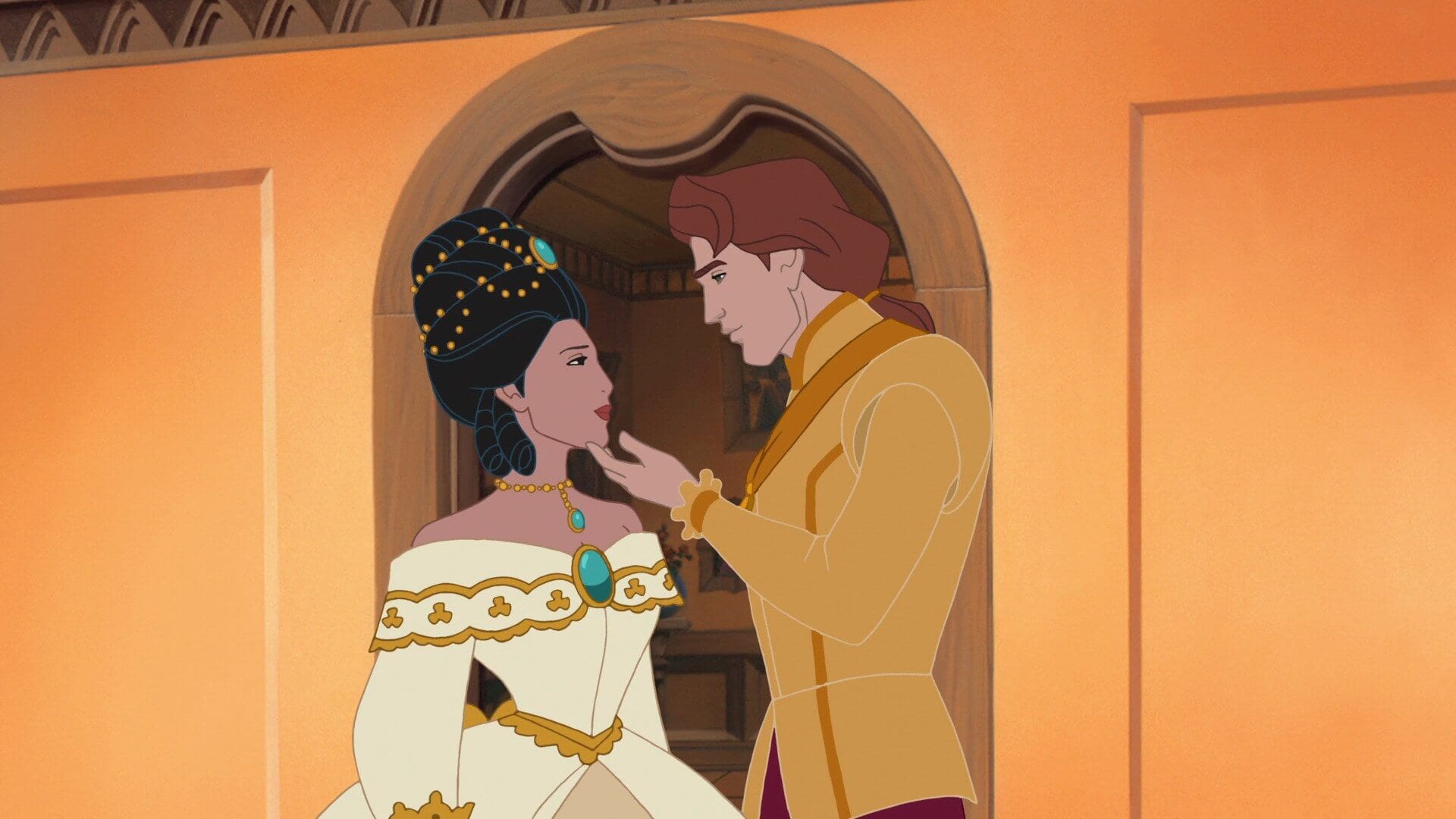REVIEW: Pocahontas II: Journey to a New World (1998)
Disney’s Pocahontas was one of my favorite movies as a kid, but it’s one of those films that doesn’t hold up well at all over time. As I got older, I started recognizing patterns in movies I liked, as opposed to those I didn’t care much for, and got interested in critiquing them. Suffice it to say, Pocahontas doesn’t stand up to any kind of critical thinking and fails to create compelling characters, an exciting story, or much of anything aside from pretty visuals and iconic music. Today, I’d like to take a look at the direct-to-video sequel, Pocahontas II: Journey to a New World. As a kid, when this film was released, I really, really hated it. I had the VHS, but probably only watched it once; I didn’t like Pocahontas’ new outfits or the fact that she didn’t marry John Smith, and even then, I knew something wasn’t right with the film visually. Let’s take a look.
Pocahontas II: Journey to a New World opens with John Smith in his house, going over maps and charting a course. Soldiers break in and attack him, and Governor Ratcliffe arrives, stating that King James believed his telling of what happened in Jamestown; he drops John off the rooftop, plunging him into the river below. Ratcliffe then appears before the King, crying and telling him how John must have died in an accident, and begging him to attack the Native Americans and seize their land and the gold he still believes is there. Meanwhile, in America, Pocahontas is grieving Smith’s death as her friend Nakoma encourages her to move on. Another English ship arrives at Jamestown, this time carrying John Rolfe on a mission to bring Chief Powhatan back as an emissary of the King. Powhatan refuses to leave, saying that since James is the one who wants the land, he should come to him. Ultimately, Pocahontas decides to go back to England with Rolfe, despite the upset this causes to her people, including Nakoma and Powhatan. Pocahontas experiences a bit of culture shock in London, and the people there are equally shocked by her. It’s up to her, with the help of John Rolfe, to play the game well enough, get an audience with the king, and convince him to reconsider attacking her tribe.
In some ways, Pocahontas II: Journey to a New World is more historically accurate than the first film, but it is hindered by what’s come before and still amounts to historical fan fiction. However, it’s doubtful that anyone would watch this movie for historical accuracy anyway; I just find it interesting that it tries harder than Pocahontas in this regard. In fact, I’d argue that this film tries harder and succeeds more than its predecessor in a few ways. The film gets to work early on establishing the characters’ personalities and their relationships; the first one didn’t focus much on the development of its characters, so for all intents and purposes, Pocahontas II: Journey to a New World has to start from the ground up. The few moments Pocahontas shares with Nakoma in this film do more for their relationship than the entirety of Pocahontas; this is done efficiently and effectively by giving them meaningful conversations and showing how they feel with their facial expressions and body language. The first Pocahontas film’s greatest strength lies in its music and animation, but even then, the characters looked very stoic. The designs and color schemes were amazing, and you had master animators like Mark Henn and Glen Keane working on that movie; however, probably in an attempt to make the characters sexy, they drew them with very plain facial expressions. Even in scenes where Pocahontas is crying or overjoyed, her face is stagnant and her emotions muted. In Pocahontas II, possibly to compensate for the lower budget and less impressive visuals, they put a lot more emphasis on character animation, and it really pays off. Animation is an incredible medium because you can create anything you can imagine and share it with the audience, and I feel like the sequel tries harder to take advantage of that opportunity.

The dialogue in Pocahontas II: Journey to a New World also shows more character than that of the first film. There are stupid jokes intended for kids, but there are also important conversations between characters, and valid questions raised. They present this idea that Pocahontas has to change and assimilate to get King James’ respect and consideration for her people. This is introduced at John Rolfe’s house when his maid, Mrs. Jenkins, powders Pocahontas’ face and John replaces her mother’s necklace with a more traditional English one; near the end, there’s a beautiful scene in which Pocahontas contemplates who she really is. Normally, I roll my eyes a little bit at personal identity messages in movies like this because they’re so played out, but like Moana, this one works for me because it’s not just about one person’s petty concerns. The internal struggle in Pocahontas II is all about how much Pocahontas should be willing to compromise and assimilate into English society to be most persuasive to the King. It’s a question of whether her cultural heritage is inherent to who she is and whether that can be compromised in order to achieve her ultimate goal. I also think it’s good that they did this because, in the first film, Pocahontas has about as much personality as a piece of toast. The relationship between Pocahontas and John Rolfe is also handled better than that between her and Smith. We’re still not talking Beauty and the Beast levels of chemistry and development, but again, they have serious conversations and some genuinely funny banter. It’s also easier to understand who Rolfe is and what motivates him because he tells Pocahontas as much early in the film.
The voice acting in Pocahontas II: Journey to a New World is pretty good as well. Irene Bedard and Judy Kuhn return as Pocahontas’ speaking and singing voices, respectively, and they’re great again. They did an excellent job initially finding a singer whose voice blends so well with Bedard’s. Russell Means also returns to voice Powhatan, though he has a smaller role this time around. Mel Gibson is replaced by his brother Donal this time around, but he’s a great replacement. You can hardly tell the difference in his voice, and he’s quite funny in the role. David Ogden Stiers and Linda Hunt also return to voice Ratcliffe and Grandmother Willow, with Michelle St. John briefly voicing Nakoma again as well. New additions include Billy Zane as John Rolfe, Brad Garrett as Uttamatomakkin, Jean Stapleton as Mrs. Jenkins, and Jim Cummings as King James. Pretty much everyone is good here, and Zane is a really good singer; I wish he had a whole song to himself. His part in “Wait ‘Till He Sees You” is one of my favorite scenes in the film. If I had to choose a weak point, it would be Cummings as King James. His performance is very exaggerated, and for a character like this, it just doesn’t work. I feel as though King James should have been more serious and level-headed, and this applies to the animation on him as well.
*Spoilers*

That being said, I’m not arguing that Pocahontas II: Journey to a New World is perfect, or even great. Given the budget constraints for a direct-to-video sequel, I think the music and visuals are actually pretty good. The musical score by Lennie Niehaus isn’t anything special, but it is pretty enough. The film’s original songs by Marty Panzer and Larry Grossman vary from pretty good (“Where do I Go From Here?”) to mediocre (“What a Day in London”). There are shots and scenes in this movie that are absolutely gorgeous, but then you have the animation on James and Ratcliffe, which is far too cartoony for what they’re trying to get across. For that matter, Ratcliffe should not be in this film at all; he was one of the worst aspects of the already mediocre Pocahontas, and honestly, there’s no reason to bring him back anyway. The real enemy here is racism and misunderstanding different cultures, so I’m not sure why we need a character to embody this and do it in such a ridiculous fashion. While the animation on the heroes improved in Pocahontas II: Journey to a New World, the animation on Ratcliffe got worse and lost that little bit of subtlety it once had. It’s almost a shame because Stiers is great here, but he almost always is. The animal sidekicks are annoying again, and I feel like Mrs. Jenkins is a character you’ll either love or hate. I found her funny, but it’s not hard to imagine someone finding her irritating. Finally, there’s a fake-out here where they want you to believe John Smith is dead until he shows up later in the film. I feel like nobody would fall for this one, not even little kids. He just falls in the river, and everyone assumes he’s dead. That being said, I do like the scene where he resurfaces in a pub; it reminded me of Strider in the Prancing Pony from The Lord of the Rings.
Pocahontas II: Journey to a New World isn’t a great movie, but one that I enjoy. In fact, I like it more than Pocahontas. This film had a smaller budget, and you can see it in the animation and some of the music, but overall, I think it’s a trade-up. The budget constraints lead to more creative animation on the characters, and there’s still a lot of detail put into backgrounds and buildings. Images like Nakoma and Pocahontas parting and Pocahontas at the river near the end instill more emotion in the viewer than anything in the first film. I think the quality drop in the music is more noticeable, but I do still like the score, and there are a couple of catchy songs. It’s hard to tell if you’ll like this film because there’s a lot of good and a lot of bad, with some mediocre elements as well. I would recommend at least giving it a watch if you haven’t; you might just be surprised.
Pocahontas II: Journey to a New World
Plot - 7
Acting - 9
Directing/Editing - 7
Music/Sound - 7
Comedy - 7
7.4
Okay
Pocahontas II: Journey to a New World isn’t a great movie, but one that I enjoy. In fact, I like it more than Pocahontas. This film had a smaller budget, and you can see it in the animation and some of the music, but overall, I think it’s a trade-up. The budget constraints lead to more creative animation on the characters, and there’s still a lot of detail put into backgrounds and buildings. Images like Nakoma and Pocahontas parting and Pocahontas at the river near the end instill more emotion in the viewer than anything in the first film. I think the quality drop in the music is more noticeable, but I do still like the score, and there are a couple of catchy songs.







